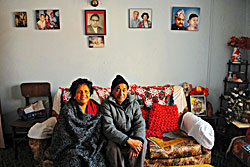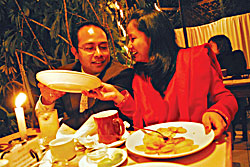 LOVE THAT LAST: Educators Renu Basnyat Shrestha, a Chhetri and Ananta Sunder Shrestha, a Newar have been married for almost 30 years and live in Kathmandu with their two sons and a daughter. |
hen wildlife activist Sanjeevani Yonzon Shrestha got married last year to Abhijeet Shrestha, it was a colourful fusion of three cultures: Hindu rituals, Lama rites and Newari ceremonies. When the 29-year-old Tamang married a Newar, she had to overcome not just a long-distance courtship that lasted eight years but also obstacles of a traditional society. But all went well in the end, and on their wedding day, Abhijeet's elder brother also wedded a Brahmin girl.
"Both of our families underwent countless meetings to decide on a common ground for wedding preparations," Sanjeevani recalls, "marriage itself is difficult and when cultural differences enter the equation it makes it twice as difficult."
A new generation of young Nepali men and women are increasingly meeting and marrying partners across caste and ethnic boundaries. Cosmopolitan, well educated and widely-travelled, they are radically redefining traditional institutions of marriage and family and forging new social norms of inclusion.
Surya Raj Joshi is a final year masters student at Kathmandu University. He says his peers don't believe in caste or ethnic restrictions anymore. "I had no problems dining at the home of a blacksmith I made friends with while traveling in Rolpa," he says.
Education, migration, the impact of mass media and recent political changes have all accelerated the trend of mixed marriages. "With globalisation and increased mobility, inter-ethnic marriages were bound to happen," says Sanjeevani.
Social anthropology professor at Tribhuban University, Suresh Dhakal, says the caste system has less meaning and the choice of a life partner becomes a personal choice as joint families fragment into nuclear ones. "With greater independence and earning power, young Nepalis tend to stay away from their parents and create distinct value systems and identities," he says.
Dhakal has seen the barriers to inter-ethnic marriages up close. He recounts childhood memories of how his mother, a Janajati married to his Brahmin father, faced ostracism and exclusion from family gatherings and religious rituals. He says that while urban Nepal is embracing more liberal attitudes towards inter-ethnic and inter-caste marriages, rural areas are still conservative and middle class values still prevail.
When Renu Basnyat Shrestha, a Chhetri, wedded her Newari husband 30 years ago, she lived away from her in-laws due to work demands. Both educators, they trained and taught at the Mahindra Ratna Multiple College in Ilam. The distance from home prevented friction. But it took time for her mother, a conservative family matriarch to accept the union.
"She was initially very resistant to the idea, but thankfully, my siblings helped to persuade her. Now, my husband is her favourite son-in-law ," Renu says, laughing.
 CROSSING HURDLES: High school sweethearts Sanjeevani Yonzon Shrestha, a Tamang, and Abhijeet Shrestha, a Newar, overcame challenges of an inter-ethnic and long distance courtship when they wedded last year. |
Academics said there are benefits of societal cross pollination. Social networks expand beyond families to castes and ethnicities, weakening discrimination and divisions. And it helps that the media highlights inter-ethnic unions.
An example is Pandragate, a 1989 film produced by popular comedic duo Hari Bansha and Madan Krishna that advocated unity among Tarai and hilly regions against the backdrop of inter-ethnic marriages.
And Brahmin Hari Bansha's 29-year partnership with Madhan Krishna, a Newar, is itself the best testimony of friendships transcending social boundaries. Furthermore, Madan Krishna himself is married to a Brahmin. "It's a national record," jokes Hari Bansha, "we're probably the longest-running Bahun-Newar partnership in Nepal."
Fears of cultural and caste dilution are irrelevant to couples Nepali Times interviewed. Sanjeevani feels she is able to carry her culture forward in an inter-ethnic family by raising her children with a balance of both customs.
Says Renu: "You should never impose an outsider mentality on yourself. I didn't think I was Chhetri and others were beneath me. Inter-ethnic marriages teach us to treat each others as equals."
Conjugal revolutionaries
 FAMILY BLISS: Hisila Yami, Baburam Bhattarai and their daughter Manushi in Germany in 1993, where Bhattarai was participating in a 'Save Gonzalo' campaign and Yami was pursuing her masters degree in England. |
Minister of Tourism and Civil Aviation Hisila Yami gained exposure to village life after she, a Newar, married Finance Minister Baburam Bhattarai, a Brahmin from Gorkha.
They met as students in Delhi and when Bhattarai went underground in 1996, so did she. The war years were difficult as the couple traveled incognito across Nepal and across the Indian border.
"I've gained from our marriage not only in terms of knowing each other's cultural mindsets but also geographically we are so different. Being a Newar I feel more enriched now knowing about Brahmin society," says Yami.
Their daughter, 22-year-old Manushi, says she enjoys the best of both worlds growing up in an inter-ethnic family. "I never get sandwiched between caste sentiments of Brahminism and Newarism," she explains, "my family became more open to ethnic differences." Manushi, who is doing her masters in political science at Tribhuban University, lives with her aunt because both her parents are too busy.
But the whole family does get together whenever they find the time. Bhattarai and Yami don't just have ethnic differences: they also have opposite personalities. "This is probably why we have had such a smooth marriage, because we are so different," Bhattarai told Nepali Times.
Still poles apart
 |
While inter-ethnic and inter-caste marriages are on the rise in the cities. Traditional mores are harder to dislodge in rural areas. In fact, prejudices and customs are so entrenched that even the supposedly progressive Maoists have been reluctant to accept inter-ethnic marriages.
Rajkumar Sada's (pictured) decision to marry a Janajati girl ended up in violence in his village of Katari was attacked by her community. The Dalit wanted to file a case with the local administration but was uncertain if any action would be taken at all.
The price was higher to pay for Laxman Dhami in Sindhuli who wed a girl from a lower caste. According to him, the Maoists extorted Rs 80,000 from his family in return for allowing him to return and allowed to "retain" his caste purity. The couple could only afford to pay one quarter of the sum to keep their home intact.
Ever since the abolishment of the Muluki Ain in 1963, there have been at least 40 constitutional codes banning untouchability and outlawing caste-based discrimination. But in reality, these traditions may take some more time before they disappear altogether.


